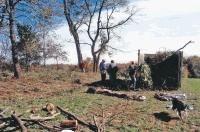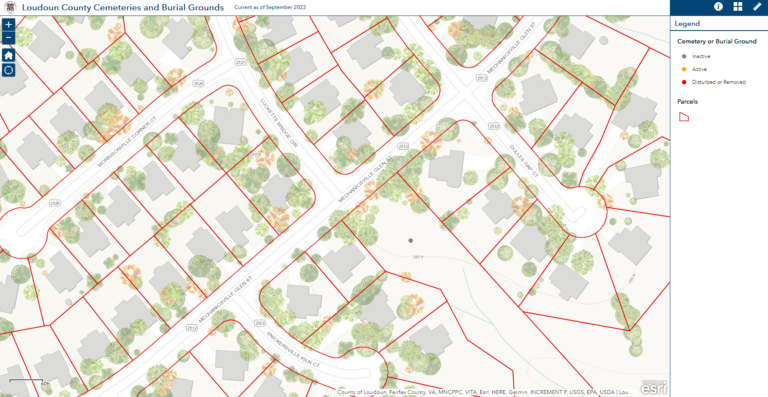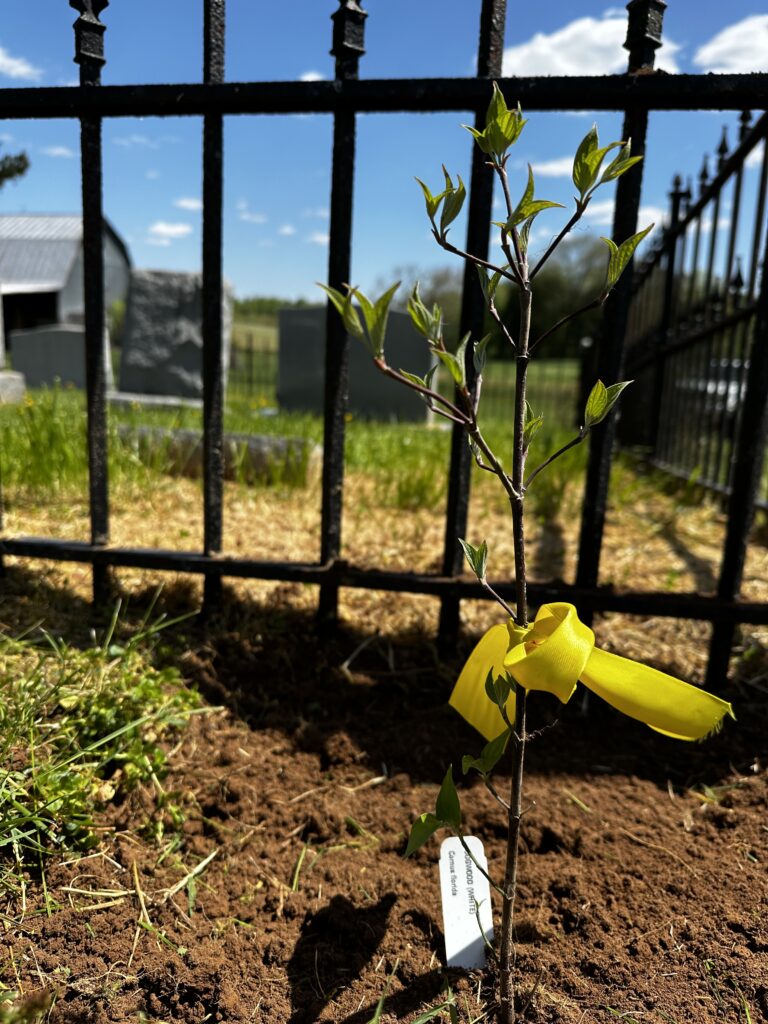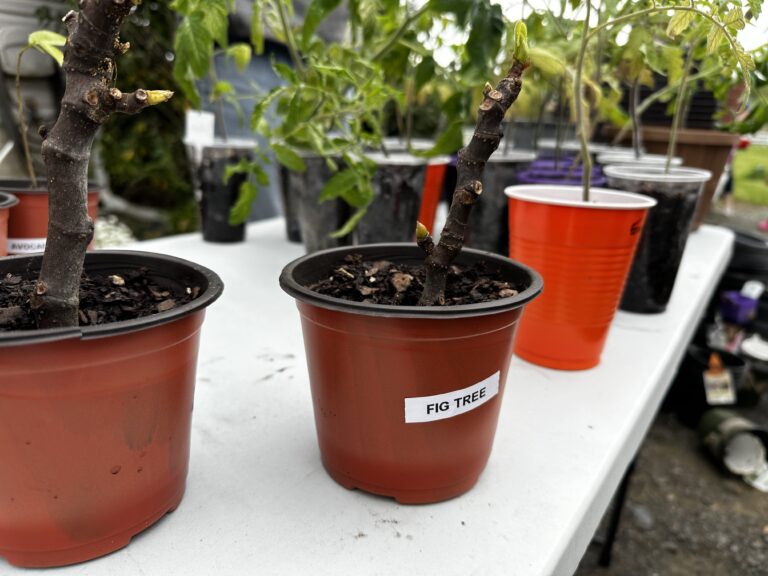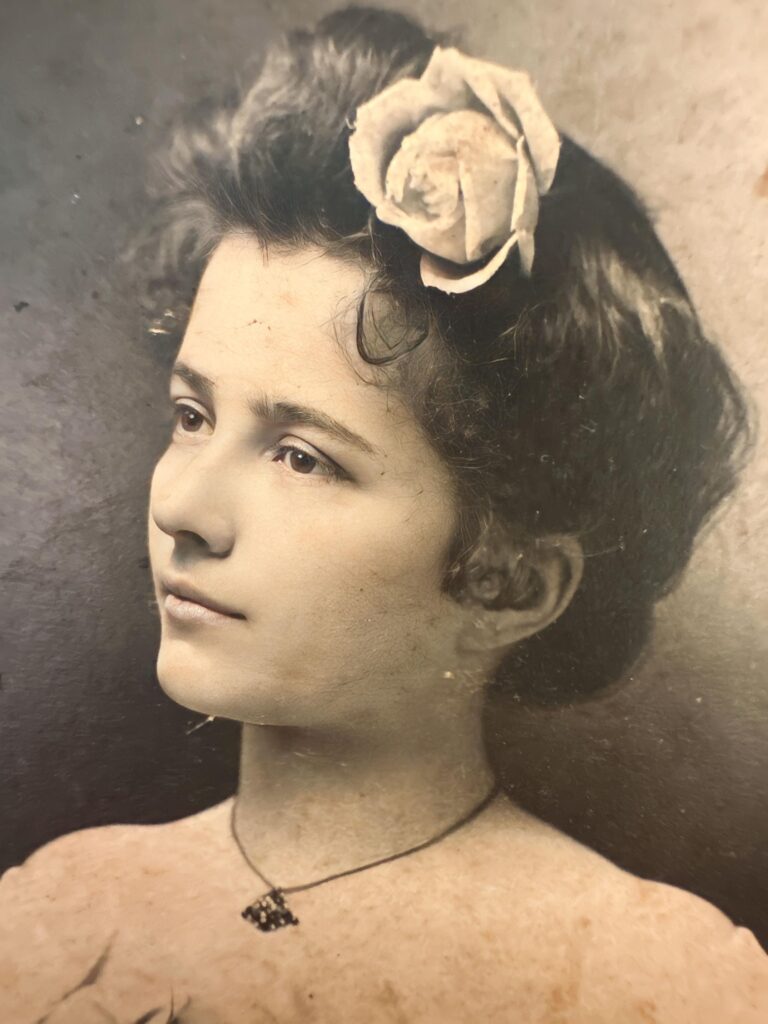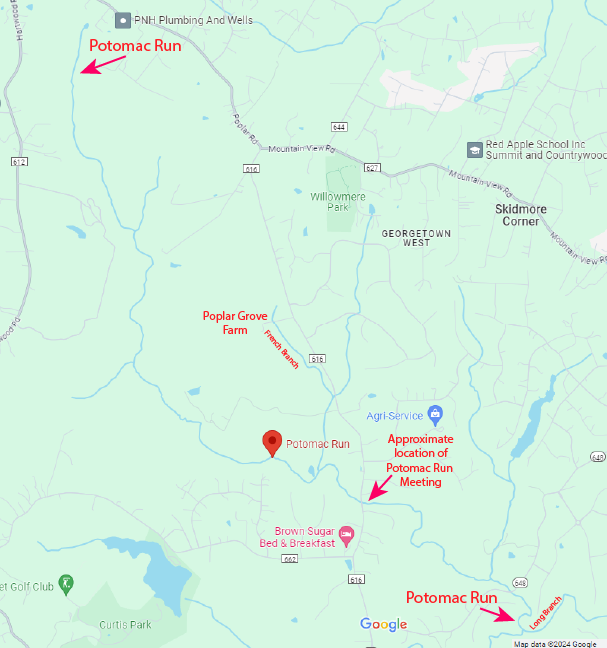Our slave cemetery was cleaned up in 2007, and it was featured by the Free-Lance Star Newspaper:
Rising like an island from a rolling hayfield sea, a one-time servants cemetery begun in the early 19th century has been reclaimed from the undergrowth, reviving another patch of Stafford’s historical past.
In three hours on a recent Saturday morning a crew of some 16, armed with bush axes, machetes, pruning shears, pitchforks, rakes and a chain saw, cleared the quarter-acre knoll of natural debris and dead trees. The detritus was thrown into a Dumpster loaned by the Stafford County landfill, and when that was full the rest was piled a distance away to be burned.
The cemetery was begun in 1830, the year the ancestors of the present owners bought the land in North Stafford now known as Poplar Grove Farm. The names of those buried there are unknown. The first were slaves, believed to be mostly children. The estimated 20 graves are marked only by scattered uncut fieldstones. The last burial, of the infant daughter of a servant of the family, was in the 1930s.
A white sign marking the entrance to Poplar Grove Farm says “8 Generations” and “Est. ca. 1830.” The fifth generation, Sallie Lou Fitzhugh, runs it today. A nephew, a great-niece and two great-great-nieces and a great-great-nephew (who live on a modern house near the entrance) carry the family line beyond her.
Sallie Lou, 76, lives up the lane from Poplar Road, on the foundation of the original 1700s house in southwest Stafford County. Hers is the third such structure; the first was torn down nearly a century ago because her mother found it “too cold and drafty,” and the second burned in 1934. “This house is pretty good for country living,” Sallie Lou said as she prepared sandwiches for the cemetery cleanup crew.
The servants’ graveyard is a quarter mile across the fields from the house, perched on a crest of the recently mowed hayfield. In its reclaimed state, the graveyard is still marked by sturdy trees, including wild cherry, persimmon (the crew tasted the newly fallen fruit and found it delicious), crape myrtle and cedar (the traditional marker of a cemetery site). There are no poplars.
“Sallie Lou said she needed help to clean this cemetery up,” said Anita Dodd, who is chairwoman of Stafford’s Cemetery Committee. “The fall is a good time, when the vegetation is down.”
Among those in her crew were Linda Belles, coordinator of the committee’s Adopt-a-Cemetery Program; Dave Russell, president of the Stafford County Historical Society; Ricky Scites, the bearded president of Stafford Civil War Sites; Barbara Flack, the historical society’s historian; Jane and Al Connor and Debbie Shelton, Historical Society stalwarts; Wendy Wheatcraft, county historic preservation planner; and others, all sawing, cutting, chopping and dragging.
These people, and scores of others, have over the years helped uncover some 400 cemeteries found so far in Stafford County. The oldest, in the Aquia area, dates back to the early 1700s, when Stafford was first settled by Europeans. “First we find the cemeteries,” said Dodd, “then we clean them up, and then we try to preserve them.”
Hugh Muir: 540/735-1975
Email: hmuir@freelancestar.com
Muir, Hugh.”African-American cemeteries reclaimed: VOLUNTEERS PITCH IN TO CLEAR BRUSH.” Free-Lance Star [Fredericksburg, Virginia], Nov 13, 2007. https://fredericksburg.com/local/african-american-cemeteries-reclaimed-volunteers-pitch-in-to-clear-brush/article_eea4a35c-4993-5222-8bc8-904b3897e478.html .
In this article Sally Lou’s name is misspelled. I painted the sign mentioned in the article, which rotted away and is gone now. I’m the great neice mentioned in the article. We do know some of the last names of slaves buried in the slave graveyard. Buried here are 6 of the 16 children born to Betty Jones, slave, and probably many others. I wasn’t there when Aunt Sally Lou made the sandwiches, but she was known for her tuna fish sandwiches and deviled eggs. The poor-quality image is the only one available from the FLS.
Letters to the Editor about the Slave Graveyard
Here’s a couple of Letters to the Editor that mentions our slave cemetery from the FLS:
This is regarding the Aug. 29 [2008] article titled “Burial ground of slaves to become a memorial.”
I am compelled to bring attention to the many slave cemeteries in Stafford County. Although there are several, I visited two of them often when I was chairman of the county’s cemetery committee.
One of these is located on the grounds of Sally Fitzhugh’s personal property and the other is in the England Run subdivision.
The cemetery in England Run, once belonging to the antebellum Ellerslie plantation, was reduced in size and remains now as a 40- by 40-foot plot. This was done during the development of the subdivision.
I strongly suggest that the historical society of Stafford County take action, follow the example of Richmond mentioned in the article, and preserve not just the two cemeteries I mentioned above, but all of those located within the county.
Price, Charles H. “Letter to the Editor: Slave burial grounds abound in Stafford.” Free-Lance Star [Fredericksburg, Virginia], Sep 10, 2008. https://fredericksburg.com/opinionletter/slave-burial-grounds-abound-in-stafford/article_3ae64526-da54-5880-9201-207fce8b7ab6.html
Since 1995, Stafford County has been very active in trying to protect its cemeteries. That is when I requested the formation of an advisory committee. This motion was passed by the Board of Supervisors on June 25, 1995.
Since that time we have registered, with the help of our committee and the residents of Stafford, over 350 cemeteries.
Recently there has been lots of interest in the area about the slavery times. I believe this is an important period in our history. Whether we like it or not, it is history that must be remembered.
During the late ’90s, I registered two large slave cemeteries that were very important places. One was located on Poplar Road on the famous farm of Sally Lou Fitzhugh. It sits on top of a hill in a very large open field. If any one or group would like to help, we would like to clean it up and have a sign put up. It is beautifully located.
The second slave cemetery was also nicely located under several very large oaks. Both cemeteries had many graves. The graves always faced east, I was told by historians.
This second cemetery has run into bad luck. It was located on the Ellersby Plantation off Truslow Road. The land has been sold to the Silver Cos., and the cemetery was approximately 105 feet by 75 feet.
Last year, a group went by to check out both cemeteries. The Ellersby Plantation Cemetery has been reduced to 40 feet by 40 feet, and some of the cemetery soil has been used to build two houses by bulldozing it from the cemetery. All of the stones are gone.
Charles H. Price
Falmouth
Price, Charles H. “Letter to the Editor: Old cemeteries need protection from development.” Free-Lance Star [Fredericksburg, Virginia], Mar 18, 2003. https://fredericksburg.com/opinionletter/old-cemeteries-need-protection-from-development/article_e46ebed6-2de0-5e1c-aee2-fc45a47e0c9a.html

